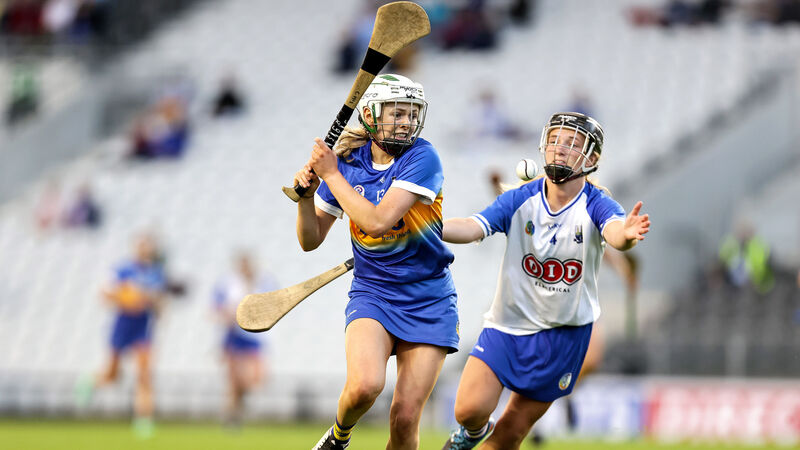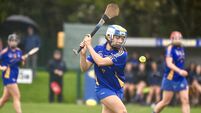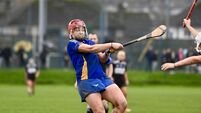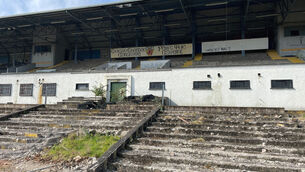Eimear Ryan: Tipperary face an uphill battle to experience the winner effect

Tipperary’s Orla O’Dwyer goes for a point under pressure from Waterford’s Kate Lynch in the All-Ireland senior camogie championship quarter-final in Páirc Uí Chaoimh.
In his 2012 book, , psychologist Ian Robertson explores the neuroscience behind success and failure. The ‘winner effect’ is a term used in biology to describe how an animal that has won a fight against a weaker opponent is much more likely to win a subsequent fight, even against stronger opposition. Success breeds success, essentially — and of course, this applies to humans too. Winning changes the brain: makes you more focused, more confident, and more aggressive.
In sport, we know the winner effect by other names, like ‘belief’, ‘experience’, or ‘character’. It explains how we end up with dynasties like the Kilkenny hurlers, Dublin footballers, or Cork ladies footballers — and conversely, it also explains how difficult it can be to break through, especially when playing against a dominant team.
That’s the uphill challenge facing the Tipperary camogie team in this Saturday’s All-Ireland semi-final against Galway. It’s their fourth consecutive year in the top four, but they’ve yet to clear that next hurdle of getting into an All-Ireland final. Their fellow travellers in the other semi-final berths are Cork, Kilkenny, and Galway — three counties who, for the better part of the last decade, have been steadily rotating the O’Duffy Cup between them.
This Tipp team has never even played in Croke Park — with the exception of full-back Mary Ryan, who came on as a sub in the 2006 final and in the form of her life in her 17th season. They should have had their collective Croker debut last year, having qualified for the league final, but the pandemic had other plans and the fixture was cancelled. Then they led All-Ireland champions Kilkenny into injury time in this year’s league semi-final, only to be caught at the death. It’s been hard-earned, this Croke Park appearance, and one hopes that they will enjoy it and get the best out of themselves, rather than being overawed by the occasion.
Having topped their group for the second year in a row, Tipp might have considered themselves unlucky to be drawn in last weekend’s quarter-final; in retrospect, though, the game against Waterford was a chance to blow off the cobwebs. In the first half, Tipp didn’t look quite as commanding as they had in their group matches earlier in the summer; however, they steadied up and pulled away towards the end, with Eimear McGrath’s stunning ‘look ma, no hands’ point an indication of the team’s confidence.
The Waterford game will have benefitted Tipp’s heads, if not their bodies; a number of Tipp players, including Ryan, may be carrying over knocks and niggles from last weekend. Still, they have more players at their disposal heading into this semi-final than they did for the same fixture last November. On that occasion, the latter stages of the championship overlapped with the AFLW pre-season, which meant that Tipp were without Orla O’Dwyer’s engine up front; Nicole Walsh and Ereena Fryday were also missing through injury. Tipp’s biggest disappointment that day was their lack of firepower, managing just four scores from play. By contrast, their spread of scorers has been a feature of their play this year, with five of their forwards and midfielder Fryday popping up for vital points against Waterford.
They’ll face a determined, focused, and businesslike Galway, who will feel that the All-Ireland was theirs for the taking last December, only to have been decided in the closing minutes by a Denise Gaule penalty. They will have exorcised a few demons by edging out Kilkenny by a point in the last of their group games in July, and their eyes will very much be on the prize of an All-Ireland final spot on September 12. Key battles here will be Cáit Devane and Sarah Dervan, while Fryday and her midfield partner Grace O’Brien will be trying to minimise Niamh Kilkenny’s trademark attacking runs.
Over the winter, both Cork and Kilkenny lost talismanic players to retirement in Gemma O’Connor and Anne Dalton. While many of us assumed that one or both of them wouldn’t be too long in returning in a coaching or backroom team capacity, Dalton’s sudden reappearance as Kilkenny’s sub-goalie has caught everyone by surprise. It’d be like if Joe Canning ran onto the pitch without warning next February with number 16 on his back and a bag of sliotars. With usual sub-keeper Emma Kavanagh injured, the decision not to call up intermediate keeper Sinead Farrell is surprising, but Dalton’s presence in the dressing room alone is probably worth the goalkeeping gamble.
The champions looked impressive in their quarter-final against Wexford, in particular the long-range point-scoring of their midfielders and half backs, and their ability to pick out forwards in the danger zone, with Mary O’Connell and Katie Nolan looking especially threatening up front. If they seemed shaky at times in the league this year, with tight games against Limerick and Dublin, they also ultimately emerged as champions, doing enough at all times to get over the line — the winner effect in action.
For their part, Cork are used to appearing in finals and won’t be happy to allow a third All-Ireland decider go by without their involvement. They cruised through games against Waterford, Down, and Dublin to top Group 2, and will relish an opportunity for a do-over of last year’s All-Ireland semi-final. Both teams look powerful in midfield — Denise Gaule and Grace Walsh on the one hand, with Ashling Thompson partnering either Katrina Mackey or Hannah Looney on the other — and the game may be won or lost in this quadrant.
The progress of women’s sport in the last few years has been so rapid that it’s sometimes easy to forget all of the ways, big and small, that female players don’t have quite the same access, opportunities, or exposure as their male counterparts. It was only five years ago that the All-Ireland semi-finals were broadcast on RTÉ for the first time; how long ago does that feel, already?
It’s tempting to hail the camogie semi-finals being held at Croke Park for the first time as progress, but really it’s an instance of quick thinking, the Camogie Association pouncing on the vacancy created by the rescheduling of the football semi-final between Tyrone and Kerry. Still, once you’re in, you’re in, right? In a few years we may not remember how the precedent was set; for now, I’m happy for the semi-finalists who get to play in our biggest arena, many of them for the first time.










